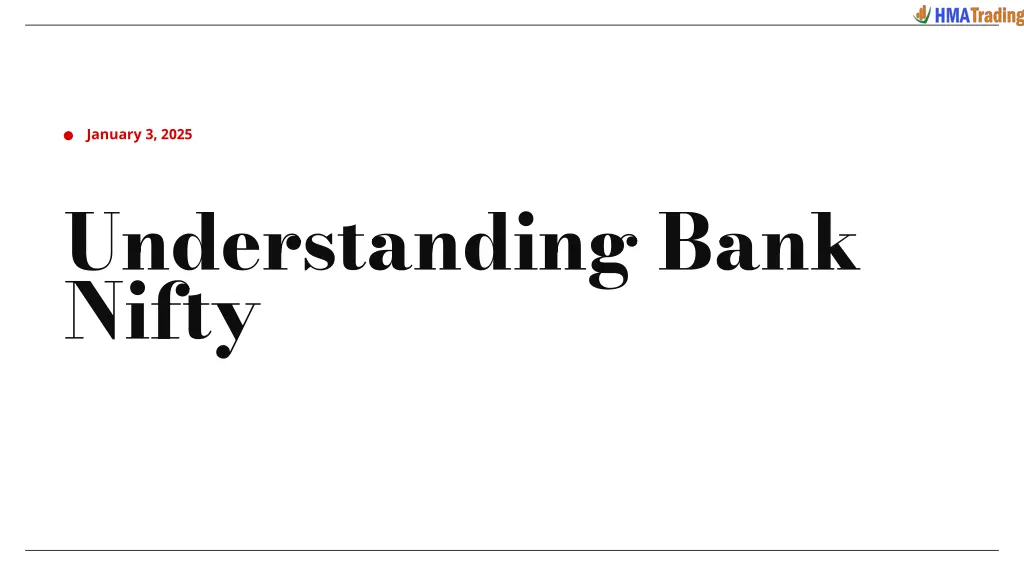
Understanding Bank Nifty and Its Importance for Traders
Discover the significance of Bank Nifty in the Indian financial ecosystem as a benchmark for the banking sector. Learn about its volatility, trading opportunities, market analysis factors, and forecasting methods for informed trading decisions.
Download Presentation

Please find below an Image/Link to download the presentation.
The content on the website is provided AS IS for your information and personal use only. It may not be sold, licensed, or shared on other websites without obtaining consent from the author. If you encounter any issues during the download, it is possible that the publisher has removed the file from their server.
You are allowed to download the files provided on this website for personal or commercial use, subject to the condition that they are used lawfully. All files are the property of their respective owners.
The content on the website is provided AS IS for your information and personal use only. It may not be sold, licensed, or shared on other websites without obtaining consent from the author.
E N D
Presentation Transcript
January 3, 2025 Understanding Bank Nifty
Agenda Intro Objectives Target audience Market landscape Customer insights Project overview Strategic initiatives Project governance Key milestones Metrics and tracking
Overview Introduction to Bank Nifty Bank Nifty is a stock market index that tracks the performance of the most liquid and well-capitalized banks listed on the National Stock Exchange (NSE) of India. Understanding Bank Nifty It serves as a benchmark for the banking sector, representing the collective performance of major public and private sector banks. Movements in Bank Nifty often reflect the overall health of the financial ecosystem in India, influencing investor sentiment and market trends. Due to its volatility, Bank Nifty provides numerous trading opportunities, making it essential for traders to understand its dynamics. As a key economic indicator, Bank Nifty's performance is closely associated with broader economic conditions, such as interest rates and GDP growth. https://hmatrading.in/
Bank Nifty Overview Importance of Bank Nifty for Traders Bank Nifty exhibits high volatility, offering significant intraday trading opportunities. Volatility and Trading Opportunities Traders can capitalize on rapid price movements for both short and long positions. The volatility attracts a variety of traders, enhancing market activity. Bank Nifty options and futures are highly liquid, facilitating easy entry and exit. Liquidity and Market Dynamics High liquidity reduces the cost of trading by minimizing slippage. A liquid market allows for better price execution and strategy implementation. https://hmatrading.in/
Market Analysis Factors Influencing Bank Nifty Movements RBI Policies and Interest Rates Global Market Trends Earnings Reports Changes in the Reserve Bank of India's monetary policies, including repo and reverse repo rates, directly impact bank profitability and Bank Nifty's performance. International financial events, such as interest rate changes by the US Federal Reserve or geopolitical issues, can significantly influence Indian markets and Bank Nifty. Quarterly earnings of banks affect Bank Nifty directly; strong results can drive the index up, while poor performance may lead to declines. Economic Data Releases Sectoral News FII and DII Activity Data points like GDP growth, inflation, and employment rates shape investor sentiment, influencing the direction of Bank Nifty. News about banking reforms, mergers, acquisitions, and regulatory changes can trigger immediate and substantial movements in Bank Nifty. Buying and selling activities of Foreign Institutional Investors and Domestic Institutional Investors significantly impact the flows and volatility of Bank Nifty. https://hmatrading.in/
Forecasting Methods for Forecasting Bank Nifty News and Sentiment Analysis Technical Analysis Fundamental Analysis Historical Data Analysis Utilizes chart patterns, support and resistance levels, and indicators like RSI and Moving Averages to predict price movements. Involves examining the financial health of banks through their balance sheets and key ratios, alongside macroeconomic indicators. Focuses on monitoring financial news and social media sentiment to gauge market reactions and trends. Analyzes past price trends and patterns in Bank Nifty to identify recurring cycles and seasonal behaviors. https://hmatrading.in/
Trading Strategies Tips for Trading Bank Nifty Stay Updated: Regularly follow news related to the banking sector, economic indicators, and global market trends to make informed trading decisions. Risk Management: Implement stop-loss orders and position sizing to mitigate potential losses and protect capital during market fluctuations. Choose the Right Timeframe: Determine the trading style that suits you whether intraday, swing trading, or positional trading and select a corresponding timeframe for analysis. Follow Market Trends: Analyze and trade in the direction of the prevailing market trend to increase the likelihood of successful trades. Avoid counter-trend trading unless there is a strong indicator to do so. https://hmatrading.in/
Forecasting Tools and Resources for Forecasting Charting Platforms News Apps Platforms like TradingView and Zerodha Kite offer advanced charting features and technical analysis tools essential for forecasting Bank Nifty. Apps such as Moneycontrol, ET Markets, HMA Trading and Bloomberg provide real-time updates on market news, crucial for traders monitoring Bank Nifty movements. Economic Calendars Community Forums Using economic calendars from sites like Forex Factory or Investing.com helps traders stay informed about upcoming economic events affecting Bank Nifty. Engage with other traders on platforms like Trading Q&A and StockTwits to share insights, strategies, and forecasts regarding Bank Nifty. https://hmatrading.in/
Summary Continuous learning and adaptability are essential for successful Bank Nifty trading. In conclusion, understanding Bank Nifty involves recognizing its significance in the Indian stock market and the factors influencing its movements. Traders should focus on technical and fundamental analysis, stay updated on economic indicators, and be aware of global trends. Risk management is crucial for minimizing losses. Ultimately, success lies in continuous learning & adaptability to navigate the complexities of Bank Nifty effectively. https://hmatrading.in/
